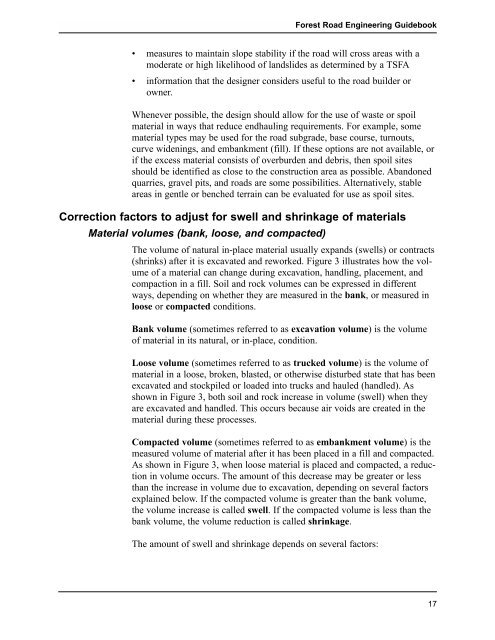Forest Road Engineering Guidebook - Ministry of Forests
Forest Road Engineering Guidebook - Ministry of Forests
Forest Road Engineering Guidebook - Ministry of Forests
You also want an ePaper? Increase the reach of your titles
YUMPU automatically turns print PDFs into web optimized ePapers that Google loves.
<strong>Forest</strong> <strong>Road</strong> <strong>Engineering</strong> <strong>Guidebook</strong><br />
• measures to maintain slope stability if the road will cross areas with a<br />
moderate or high likelihood <strong>of</strong> landslides as determined by a TSFA<br />
• information that the designer considers useful to the road builder or<br />
owner.<br />
Whenever possible, the design should allow for the use <strong>of</strong> waste or spoil<br />
material in ways that reduce endhauling requirements. For example, some<br />
material types may be used for the road subgrade, base course, turnouts,<br />
curve widenings, and embankment (fill). If these options are not available, or<br />
if the excess material consists <strong>of</strong> overburden and debris, then spoil sites<br />
should be identified as close to the construction area as possible. Abandoned<br />
quarries, gravel pits, and roads are some possibilities. Alternatively, stable<br />
areas in gentle or benched terrain can be evaluated for use as spoil sites.<br />
Correction factors to adjust for swell and shrinkage <strong>of</strong> materials<br />
Material volumes (bank, loose, and compacted)<br />
The volume <strong>of</strong> natural in-place material usually expands (swells) or contracts<br />
(shrinks) after it is excavated and reworked. Figure 3 illustrates how the volume<br />
<strong>of</strong> a material can change during excavation, handling, placement, and<br />
compaction in a fill. Soil and rock volumes can be expressed in different<br />
ways, depending on whether they are measured in the bank, or measured in<br />
loose or compacted conditions.<br />
Bank volume (sometimes referred to as excavation volume) is the volume<br />
<strong>of</strong> material in its natural, or in-place, condition.<br />
Loose volume (sometimes referred to as trucked volume) is the volume <strong>of</strong><br />
material in a loose, broken, blasted, or otherwise disturbed state that has been<br />
excavated and stockpiled or loaded into trucks and hauled (handled). As<br />
shown in Figure 3, both soil and rock increase in volume (swell) when they<br />
are excavated and handled. This occurs because air voids are created in the<br />
material during these processes.<br />
Compacted volume (sometimes referred to as embankment volume) is the<br />
measured volume <strong>of</strong> material after it has been placed in a fill and compacted.<br />
As shown in Figure 3, when loose material is placed and compacted, a reduction<br />
in volume occurs. The amount <strong>of</strong> this decrease may be greater or less<br />
than the increase in volume due to excavation, depending on several factors<br />
explained below. If the compacted volume is greater than the bank volume,<br />
the volume increase is called swell. If the compacted volume is less than the<br />
bank volume, the volume reduction is called shrinkage.<br />
The amount <strong>of</strong> swell and shrinkage depends on several factors:<br />
17

















